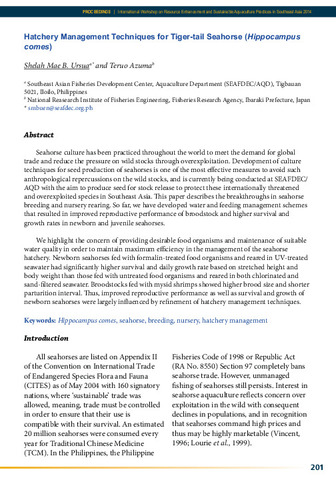Perlihatkan publikasi sederhana
The Philippines recommends for tilapia
| dc.date.accessioned | 2020-05-27T09:25:05Z | |
| dc.date.available | 2020-05-27T09:25:05Z | |
| dc.date.issued | 2018 | |
| dc.identifier.citation | The Tilapia Technical Committee 2017. (2018). The Philippines recommends for tilapia. Los Baños, Laguna, Philippines: DOST-PCAARRD. | en |
| dc.identifier.issn | 0115-7833 | |
| dc.identifier.uri | http://hdl.handle.net/10862/5837 | |
| dc.description | Tilapia is one of the most commercially important commodities in fisheries and aquaculture. Although tilapia is relatively easy to propagate and culture, the Philippine tilapia industry needs the necessary boost in the quality and quantity of production outputs. Years of local tilapia R&D works have generated several innovative field-tested breeding and farming methods, which when adopted on-farm, may help the tilapia industry attain its goals. PCAARRD, with the help of a technical team of experts has come up with an updated compilation of the latest working technologies in tilapia breeding and farming. It is hoped that fish farm technicians, students, fish farm managers/operators, and aquaculturists will benefit fully from this publication, apply the recommended techniques, and as such, contribute further to the success of the tilapia industry in the Philippines. | en |
| dc.format.extent | xvi, 123 pages : color illustrations. | en |
| dc.language.iso | en | en |
| dc.publisher | DOST-PCAARRD | en |
| dc.relation.ispartofseries | Philippines Recommends Series; No. 98/2018 | en |
| dc.subject | Tilapia (genus) | en |
| dc.subject | Oreochromis niloticus | en |
| dc.subject | Philippines | en |
| dc.title | The Philippines recommends for tilapia | en |
| dc.type | Book | en |
| dc.subject.asfa | fry | en |
| dc.subject.asfa | breeding stock | en |
| dc.subject.asfa | hatcheries | en |
| dc.subject.asfa | seed collection | en |
| dc.subject.asfa | seed production | en |
| dc.subject.asfa | rearing techniques | en |
| dc.subject.asfa | nursery ponds | en |
| dc.subject.asfa | fingerlings | en |
| dc.subject.asfa | pond culture | en |
| dc.subject.asfa | site selection | en |
| dc.subject.asfa | pond construction | en |
| dc.subject.asfa | stocking density | en |
| dc.subject.asfa | feeding | en |
| dc.subject.asfa | feeds | en |
| dc.subject.asfa | water management | en |
| dc.subject.asfa | disease prophylaxis | en |
| dc.subject.asfa | disease control | en |
| dc.subject.asfa | growing ponds | en |
| dc.subject.asfa | polyculture (aquaculture) | en |
| dc.subject.asfa | harvesting | en |
| dc.subject.asfa | cage culture | en |
| dc.subject.asfa | stocking (organisms) | en |
| dc.subject.asfa | aquaculture techniques | en |
| dc.subject.asfa | fish kill | en |
| dc.subject.asfa | processing fishery products | en |
| dc.subject.asfa | packing fishery products | en |
| dc.subject.asfa | frozen products | en |
| dc.subject.asfa | refrigerated foods | en |
| dc.subject.asfa | hygiene | en |
| dc.subject.asfa | dried products | en |
| dc.subject.asfa | fish handling | en |
| dc.subject.asfa | packaging materials | en |
| dc.subject.asfa | product labelling | en |
| dc.subject.asfa | marketing | en |
| dc.subject.asfa | pricing | en |
| dc.subject.asfa | costs | en |
| dc.subject.asfa | returns | en |
| dc.contributor.corporateauthor | The Tilapia Technical Committee 2017 | en |
Files in this item
| Files | Size | Format | View |
|---|---|---|---|
|
There are no files associated with this item. |
|||




